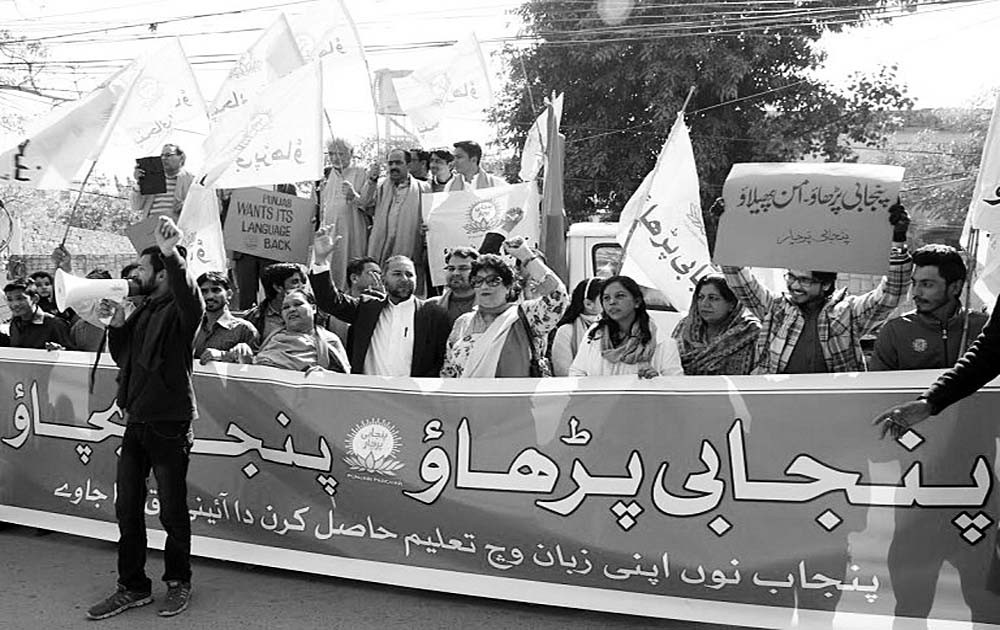
Punjabi intelligentsia and Mother Language Day

This year, too, the Mother Language Day on 21st February did not go by un-noticed. In Lahore, Punjabi enthusiasts adopted different ways to sensitise the general populace to wholeheartedly embrace Punjabi as a medium of exchange at homes. Demand for employing Punjabi as a medium of instruction at the educational institution was voiced yet again with extraordinary zeal. This year was distinct in that a few events of discursive nature were organised at some premier institutions like the Lahore University of Management Sciences (LUMS) and Beaconhouse National University (BNU).
I came to know that a similar event was held at the Punjabi Institute of Language and Literature in which my dear friend and founder of Khoj Garh, a Punjabi Research Centre in the suburbs of Lahore, Iqbal Qaiser received the Shafqat Tanvir Mirza Award for his book Ujrray Darran Dey Darshan. Iqbal Qaiser has devoted a better part of his life for the cause of mother tongue’s promotion which is commendable. His earlier work on Sikh Gurdwaras got international acclaim.
I had a chance to participate in the two events organised by LUMS and BNU respectively where I was lucky enough to meet many Punjabi laureates, enthusiasts and activists. Needless to say, the experience was enriching. At LUMS, the Dean of Arts and Social Sciences, Mushtaq Ahmad Gurmani School of Humanities and Social Sciences, and the Gurmani Center of Literature and Languages had organised the Punjabi Conference as a collaborative effort. Prof. Moin Nizami, director of the Gurmani Center, was the focal person. Along with him, Dr Manzur Ejaz, an eminent writer based in Washington DC and Mushtaq Soofi, a known writer, columnist and the Chairman of Punjabi Adabi Board, were instrumental in putting that event together.
The organisers must be lauded for taking that momentous step. They provided the Punjabi intelligentsia with a platform to deliberate on the challenges their language and culture are faced with. The announcement that it will be an annual affair was indeed a good tiding for all those nursing some concern for Punjabi.
Against this context, I have a few observations to make. These are partly connected with the discourse generated at the LUMS conference and partly with the general state of Punjabi as a language.
Several presentations at the conference depicted the region under study (the Punjab) in the light of a presumed "ontological purity". In simpler terms, the region was inherently an epitome of all that can be designated as ‘good’ by current standards: there was no caste or class hierarchy; there was gender equality; and appropriation of surplus value from the peasantry by the powerful was starkly nonexistent. This was the thrust of the discourse -- quite a romantic view about pre-modern Punjab, a utopia of sorts.
I may aver that by advancing such a view, they are rendering Punjab as an ahistorical entity that should be addressed. The phenomenon that I have designated above as "ontological purity" was vitiated by invaders and settlers who not only plundered resources but began a process of socio-cultural re-engineering. That view seems to have acquired resonance with the classical brand of Indian historiography in which invaders and specifically British were usually demonised as the ‘Other’.
That particular reading of history had a Marxist tinge to it since K.M. Ashraf, D.D. Kosambi and Irfan Habib embraced it. The discourse adopted by our Punjabi intellectuals is influenced from that streak. Of course, they are devoid of the nuanced analysis and academic profundity that Kosambi and Habib demonstrate; nevertheless, the mode of analysis bears similarity to the Marxist historical discourse prevalent in the 1960s and 1970s. Most of the intelligentsia dealing in Punjabi language, literature and culture seems intellectually stuck in 1970s. The reasons for that stasis may be varied. But lack of patronage from the state and fewer professional academics among the ranks of the Punjabi intelligentsia can be advanced as the main reasons.
Majority of those lending support to the cause of the Punjabi are activists in their orientation and approach which in itself is important but academic deficit is starkly palpable. Saeed Bhutta and Anne Murphy, being trained academics, were the two exceptions. Besides, the biggest icon of Punjabi literature, Najm Hosain Syed was conspicuously absent from the conference which left a noticeable void in the whole affair.
The inadvertent exclusion of intelligentsia from the Seraiki and Potohari belts was important too. The whole affair would have been far more meaningful had it lured these streams of Punjabi culture into its fold.While adhering to the notion ‘unity in diversity’ other sub-lingual identities should be given their due space.
Verily, the most daunting task that Punjabi intellectuals are up against is the Seraiki and Pothohari separatist tendencies which remain dormant just because the state has not taken any concrete step to standardise the language, at least so far. It goes without saying that standardisation of any language, when it is brought in as an instrument of official transaction, becomes a necessary act. But the tenuous side of that act is the consigning of various dialects and sub-languages to marginality. That is what Punjabi intellectuals need to do something about.
Raising slogans for the implementation of Punjabi in educational institutions and government offices is laudable but it is likely to render Punjab culturally cracked. Several separatist identities will spring up to the detriment of the Punjabi enthusiast.
In the face of that not very promising scenario, can we formulate a theoretical framework around the notion of "unity in diversity"? Can we assure the people and cultures inhabiting the margins of the province that they are one amongst us despite the distinct-ness in their local parlance?
That indeed is a difficult undertaking which I doubt the Punjabi intelligentsia is well-equipped for. It has to be generous, creative and intellectually profound before it undertakes such a task.